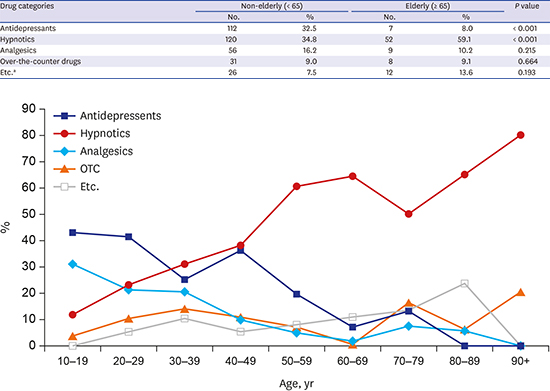1. World Health Organization. World Health Statistics 2016: Monitoring Health for the SDGs. Geneva, Switzerland: World Health Organization;2016.
2. Korea Suicide Prevention Center Research Brief 2017: suicide rate per 100,000 people according to gender. Updated 2017. Accessed August 16, 2017.
http://www.spckorea.or.kr/index.php.
3. Manuel JI, Lee J. Gender differences in discharge dispositions of emergency department visits involving drug misuse and abuse-2004–2011. Subst Abuse Treat Prev Policy. 2017; 12(1):28.

4. Organisation for Economic Co-operation and Development. OECD Health Statistics 2016. Paris, France: Organisation for Economic Co-operation and Development;2016.
5. Mathers CD, Stevens GA, Boerma T, White RA, Tobias MI. Causes of international increases in older age life expectancy. Lancet. 2015; 385(9967):540–548.

6. Chatterji S, Byles J, Cutler D, Seeman T, Verdes E. Health, functioning, and disability in older adults--present status and future implications. Lancet. 2015; 385(9967):563–575.

7. Shah A, Bhat R, Zarate-Escudero S, DeLeo D, Erlangsen A. Suicide rates in five-year age-bands after the age of 60 years: the international landscape. Aging Ment Health. 2016; 20(2):131–138.

8. Shah A. The relationship between suicide rates and age: an analysis of multinational data from the World Health Organization. Int Psychogeriatr. 2007; 19(6):1141–1152.

9. Koo YW, Kõlves K, De Leo D. Suicide in older adults: differences between the young-old, middle-old, and oldest old. Int Psychogeriatr. 2017; 29(8):1297–1306.

10. Koo T, Lee K, Seo WS, Lee JH, Kim HC, Lee SW, et al. Comparison of clinical characteristics between single and repeated suicide attempters admitted to emergency room. J Korean Neuropsychiatr Assoc. 2016; 55(3):224–233.

11. Kim WH, Choi YG, Kim SJ, Cho SH. A study on the effect of the depressive disorder in suicidal attempt aspect. J Korean Soc Emerg Med. 2010; 21(5):670–677.
12. Özer E, Gümüş B, Balandiz H, Kırcı GS, Aydoğdu HI, Tetikçok R. Evaluation of geriatric suicides in Turkey. J Forensic Leg Med. 2016; 44:158–161.

13. Alexopoulos GS, Young RC, Meyers BS. Geriatric depression: age of onset and dementia. Biol Psychiatry. 1993; 34(3):141–145.

14. Taylor WD, Aizenstein HJ, Alexopoulos GS. The vascular depression hypothesis: mechanisms linking vascular disease with depression. Mol Psychiatry. 2013; 18(9):963–974.

15. Alexopoulos GS, Meyers BS, Young RC, Campbell S, Silbersweig D, Charlson M. ‘Vascular depression’ hypothesis. Arch Gen Psychiatry. 1997; 54(10):915–922.

16. Taylor WD. Clinical practice. Depression in the elderly. N Engl J Med. 2014; 371(13):1228–1236.
17. Dong X, Bergren S, Simon MA. Cross-sectional and longitudinal association between trust in physician and depressive symptoms among U.S. community-dwelling chinese older adults. J Gerontol A Biol Sci Med Sci. 2017; 72:S125–30.

18. Isacsson G, Ahlner J. Antidepressants and the risk of suicide in young persons--prescription trends and toxicological analyses. Acta Psychiatr Scand. 2014; 129(4):296–302.
19. Unützer J, Katon W, Callahan CM, Williams JW Jr, Hunkeler E, Harpole L, et al. Depression treatment in a sample of 1,801 depressed older adults in primary care. J Am Geriatr Soc. 2003; 51(4):505–514.
20. Yoon JH, Park SJ. Review of antidepressants treatment in late-life depression. J Korean Geriatr Psychiatry. 2013; 17(1):8–13.
21. Conwell Y, Duberstein PR, Cox C, Herrmann J, Forbes N, Caine ED. Age differences in behaviors leading to completed suicide. Am J Geriatr Psychiatry. 1998; 6(2):122–126.

22. Kuehn BM. FDA panel seeks to balance risks in warnings for antidepressants. JAMA. 2007; 297(6):573–574.

23. Mowry JB, Spyker DA, Cantilena LR Jr, McMillan N, Ford M. 2013 annual report of the American Association of Poison Control Centers’ National Poison Data System (NPDS): 31st annual report. Clin Toxicol (Phila). 2014; 52(10):1032–1283.

24. Kim SJ, Chung SP, Gil HW, Choi SC, Kim H, Kang C, et al. The poisoning information database covers a large proportion of real poisoning cases in Korea. J Korean Med Sci. 2016; 31(7):1037–1041.

25. Health Insurance Review and Assessment Service. The rate of patient treated with depression, prescription rate of antidepressant and hypnotics, and the amount of pill by age in 2015??016. Wonju, Korea: Health Insurance Review and Assessment Service;2017.






 PDF
PDF Citation
Citation Print
Print






 XML Download
XML Download